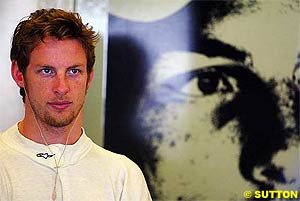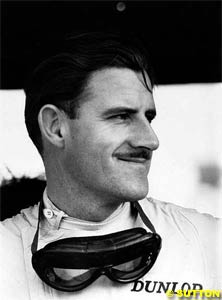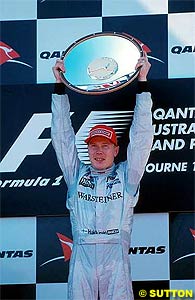
Atlas F1 Contributing Writer
The United States Grand Prix was the first race of the 2004 season where Jenson Button did not score any points and in fact the first time this year that the Briton retired with a mechanical failure. But, with half a season gone, it has become clear that Jenson Button has come of age and his first Grand Prix win is surely soon to come. Veteran journalist Barry Kalb finds similarities between Button's steady progress and two former World Champions and explains why Button is likely to join their ranks
Button has followed a well-driven path in Formula One, from young hot-shot, to apprentice becoming acquainted with all the ups and downs of racing, to a driver who finally starts to wring everything that's available out of his car of the moment. Now, in his fifth season, he's on the cusp of scoring his first win.
He has demonstrated that, given a competitive car, he can mix it up with the best of them, and he doesn't appear to be intimidated by racers like Michael Schumacher or Juan Pablo Montoya. He generally avoids mistakes, and puts himself in a position to profit from the mistakes of others. He hasn't shown the flash or raw speed of Kimi Raikkonen or Fernando Alonso, but not all World Champions have been in that category. Given the right car, Button appears to have the potential to accumulate enough wins and podiums over a season to come out on top.
Where to rank him in the pantheon of drivers remains to be seen, but two possible comparisons come to mind at this intermediate point: Graham Hill, and Mika Hakkinen, neither of whom is generally ranked among the top all-time greats, but both fine drivers and worthy champions.
The two men arguably possessed slightly different levels of driving ability, either of which might also characterize Button. Their racing histories are instructive for those who argue that Button has been slow to move up the ladder: both were well into their careers before they began winning.
Hill started his Formula One career in 1958, with Lotus. He drove the four seasons through 1961 without a win, with only a single podium finish to his credit (in 1960), and without ever becoming a serious challenger for the Championship. Then in 1962, it all came together: four wins and the Championship in the BRM, against such formidable opponents as Jim Clark, Dan Gurney and Jack Brabham.
Hill won one more race in 1969, but was badly injured in an accident at the end of that season, and thereafter drove a series of uncompetitive cars until his death in an airplane crash in 1975. He also won the Indy 500 in 1966 and Le Mans in 1972 - the only driver ever to win those two classics plus the F1 World Championship.
Hill had a famously dry wit, and was without doubt one of the most popular drivers to race in Formula One. His 14 wins put him in a tie for 13th place (with Brabham and Emmerson Fittipaldi) among the drivers with most wins of all time, and he had more than his share of poles, podiums, points and fastest laps.
Enzo Ferrari, who watched drivers come and go over a 60-year period, called Hill "solid, positive." Stirling Moss, who raced against Hill during 1958-'61 and watched him drive thereafter, described him as "the ultimate mechanic-driver," telling writer Ken Purdy:
"Perhaps he is the archetype of the driver of the future: precise, smooth, knowing…Given the equipment, he'll go really quickly, he'll stay out of trouble and if it's possible, he'll keep the machine out of trouble…He is not the type to risk blowing up an engine or going off the road to catch you, nine times in ten."
Does that sound like a description of Jenson Button? It could well be.
Mika Hakkinen, like Hill, was a highly-respected and extremely well-liked driver, who also became by any measurement one of the most successful ever. There are those who will say that - a least during his peak - he ranked with the very best. Yet it took him 95 starts, until the last race of his seventh season, before he won his first Formula One Grand Prix - far longer than other drivers of his caliber.
Hakkinen began his Formula One career with Lotus in 1991, when Lotus was past its prime, and his first two seasons were unexceptional. He joined McLaren in 1993 and scored his first podium finish, and for the next four seasons he was often on the podium, but never seriously challenged for a win. In the midst of that period, in 1995, he crashed heavily in Australia and almost lost his life.
Hakkinen's next win, in the first race of the '98 season, was also somewhat less than spectacular: Coulthard honoured a pre-race agreement between the two, again allowing Mika to win. But during the rest of that season, and until his retirement at the end 2001, Hakkinen blossomed into a great driver.
He won the championship in 1998 and 1999; he became the 11th member of that very exclusive club of drivers who have won 20 or more races; and he ranks among the top ten in every major category of racing achievement.
Hakkinen was smooth, consistent and fast, but he is also remembered for one of the most spectacular single moments in Grand Prix racing, passing both Schumacher and Ricardo Zonta simultaneously at over 300km/h to take the race lead at Spa-Francorchamps in the 2000 Belgian Grand Prix. It was a demonstration that in his most inspired moments, Hakkinen was probably as good a driver as any who ever raced.
This, too, could be Jenson Button.
The young Briton was only 20 years old when he signed with Williams in 2000. The car was respectable that year, and he scored points consistently. The next two years were spent at Benetton/Renault, where the car was anything but respectable; he struggled mightily, but also learned a lot about driving in less-than-optimum conditions, and in his second year there he began scoring consistently again.
The lessons seem to have paid off last year, when he often out-performed his teammate, former champion Villeneuve, in the underperforming BAR. This year, BAR has finally built a competitive machine, and Button is the driver Michael Schumacher consistently cites as a potential challenger. Button's best driving is probably yet to come.
The situation is beginning to resemble 1962, when everything fell into place for Graham Hill, or 1998, when the same happened for Hakkinen. It is extremely unlikely that Button or anyone else will keep Schumacher from his seventh World Championship this year, but Button's time appears to be coming. He may turn out to be a Hill, or maybe a Hakkinen. Whichever it may be, it is quite probable that he is a future World Champion.
Few drivers have excited Formula One aficionados this year more than Jenson Button. After four generally lackluster seasons, during much of which people were writing him off as a driver whose time would never come, he has evolved into a regular sight on the post-race podium – finishing in the top three six times in nine races.
 Button has begun challenging for wins. He is being discussed - again - as a future World Champion. And, for those who still question his skill, it is helpful to keep in mind that some of the most successful drivers of all time were slow to start winning, and that those who win are not always the fastest.
Button has begun challenging for wins. He is being discussed - again - as a future World Champion. And, for those who still question his skill, it is helpful to keep in mind that some of the most successful drivers of all time were slow to start winning, and that those who win are not always the fastest.
 He was a consistent challenger throughout the rest of the sixties, although hardly a barn-burner. He won two races each year in '63, '64 and '65, and none in '66 and '67. In 1968, after Clark's death, he won the Championship for a second time with three victories.
He was a consistent challenger throughout the rest of the sixties, although hardly a barn-burner. He won two races each year in '63, '64 and '65, and none in '66 and '67. In 1968, after Clark's death, he won the Championship for a second time with three victories.
 It all began to change for Hakkinen with the very last race of 1997, after the infamous coming-together between Schumacher and Jacques Villeneuve. Schumacher, who precipitated the incident as Villeneuve was about to pass him into first place, was forced to retire. Villeneuve's car was damaged, and he slowed, allowing McLaren's David Coulthard and Hakkinen through. At the request of team boss Ron Dennis, Coulthard – already a Formula One winner – gave way to teammate Hakkinen for his maiden victory.
It all began to change for Hakkinen with the very last race of 1997, after the infamous coming-together between Schumacher and Jacques Villeneuve. Schumacher, who precipitated the incident as Villeneuve was about to pass him into first place, was forced to retire. Villeneuve's car was damaged, and he slowed, allowing McLaren's David Coulthard and Hakkinen through. At the request of team boss Ron Dennis, Coulthard – already a Formula One winner – gave way to teammate Hakkinen for his maiden victory.
About the author:
Barry Kalb is a veteran journalist with more than 20 years of experience (the Washington Star, CBS News, Time Magazine) and a motor racing fan - especially Formula One - for almost 40 years. He currently resides in Hong Kong.
Please Contact Us for permission to republish this or any other material from Atlas F1.
|
Volume 10, Issue 25
Atlas F1 Exclusive
Ann Bradshaw: Point of View
Articles
2004 Half-Term Report
Jenson Button: a Hakkinen or a Hill?
2004 US GP Review
2004 United States GP Review
Precious Time
Stats Center
Qualifying Differentials
SuperStats
Charts Center
Columns
The F1 Insider
Season Strokes
On the Road
Elsewhere in Racing
> Homepage |